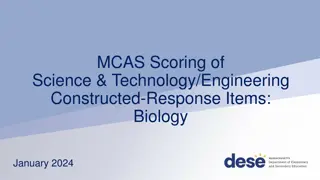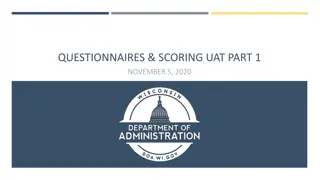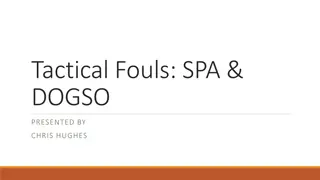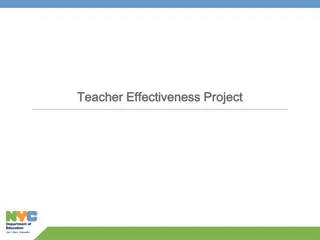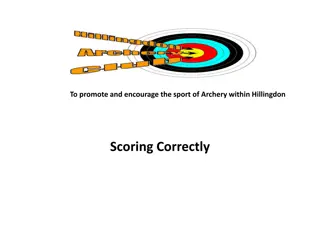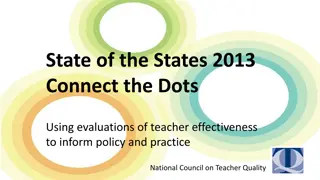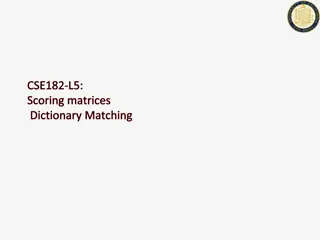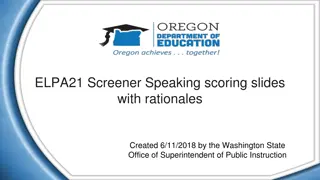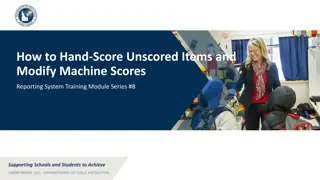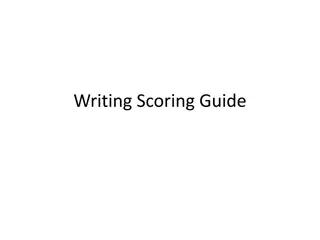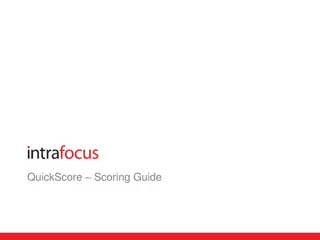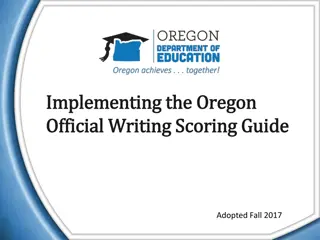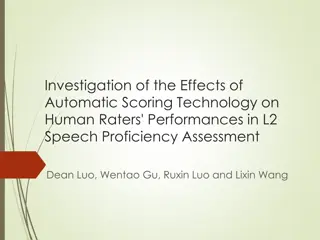AchieveNJ Teacher Evaluation Scoring Guide Overview
This presentation details how districts assess teacher performance in AchieveNJ, outlining the weighting of evaluation elements and explaining the multiple measures used. It covers teacher practice scoring, components weighting, and provides examples for calculating final ratings. Local districts have discretion in combining observation data to rate teacher practice on a 1-4 scale, with insights into the scoring process and considerations when determining component weights.
Download Presentation

Please find below an Image/Link to download the presentation.
The content on the website is provided AS IS for your information and personal use only. It may not be sold, licensed, or shared on other websites without obtaining consent from the author. Download presentation by click this link. If you encounter any issues during the download, it is possible that the publisher has removed the file from their server.
E N D
Presentation Transcript
AchieveNJ: Teacher Evaluation Scoring Guide AchieveNJ: Teacher Evaluation Scoring Guide
Overview Overview This presentation provides information on how districts compile evaluation ratings for teachers in AchieveNJ. Each element of the evaluation results in a 1 - 4 rating, which is weighted according to state formulas shown in later slides. Overviews and examples are provided for scoring each of the multiple measures. The presentation concludes with information on using each of the multiple measure ratings to calculate one final summative evaluation score for each teacher. 2
Multiple Measures Multiple Measures All teachers are evaluated based on multiple measures. Practice Practice Student Achievement Student Achievement Student Growth Student Growth Percentile Percentile (SGP) (SGP) Student Growth Student Growth Objective Objective (SGO) (SGO) Teacher Teacher Practice Practice Summative Summative Rating Rating Based on classroom observations Overall evaluation score Based on state assessment performance Set by teacher and principal Teachers of grades 4 Teachers of grades 4- -8 8 LAL and 4 LAL and 4- -7 Math 7 Math All teachers and All teachers and principals principals 3
Teacher Practice Scoring Teacher Practice Scoring Teacher practice is measured according to a district-chosen observation instrument, such as Danielson, Marzano, McREL, etc (see here for complete list). Local school districts have discretion on how to combine observation data and Local school districts have discretion on how to combine observation data and evidence about a teacher s practice evidence about a teacher s practice collected throughout the year into a final teacher practice rating on a 1 4 scale. The example that follows show how the different components of the teacher practice instrument might be calculated. This is an example, not a recommendation, as districts have discretion in determining these calculations. recommendation, as districts have discretion in determining these calculations. Please consult your District Evaluation Advisory Committee (DEAC) to inquire how this is being done locally. This is an example, not a 4
Teacher Practice: Weighting of Domains Teacher Practice: Weighting of Domains and Components and Components Across different elements of each instrument, some districts have identified certain components, standards, or domains that they would like to weight more heavily. Below is an example of how a district might weight different components: Summative Summative Teacher Practice Teacher Practice Rating Rating Planning Planning Environment Environment Instruction Instruction Professionalism Professionalism 20% 30% 20% 30% 100% Example (domain score multiplied by the weight): (3.25 x 0.20) (3.25 x 0.20) (4.0 x 0.30) (4.0 x 0.30) (3.00 x 0.30) (3.00 x 0.30) (2.00 x 0.20) (2.00 x 0.20) 3.15 3.15 5
Student Growth Objective (SGO) Scoring Student Growth Objective (SGO) Scoring SGO scoring can be approached in several ways. The specific approach must be determined at the local level (district or school), and will depend on the approach the individual teacher is taking, the subject that is being taught, and the quality of the assessment being used. In scoring an SGO, the 1 4 rating should be based on how many students included in the SGO met their goal. An example of this is shown below: Class Size Class Size Objective Attainment Based on Number of Students Achieving Target/Growth Score Objective Attainment Based on Number of Students Achieving Target/Growth Score 4 3 2 1 90% 90% students) 80% 80% 70% 70% Less than 70% Less than 70% (20 (20 or fewer ) or fewer ) met goal (27 (27 students) or more met goal (24 students) (24 students) or more met goal (21 students) (21 students) or more met goal 30 students 6
SGO Scoring SGO Scoring When teachers have 2 SGO scores, these can be averaged to reach a summative SGO rating, in this case, the teacher would receive a 2.5 in this case, the teacher would receive a 2.5 Example: Objective Attainment Based on # of Students Achieving Target/Growth Score Objective Attainment Based on # of Students Achieving Target/Growth Score 4 3 2 1 Measuring Measuring Progress Progress *90% *90% or more students met goal *80% *80% or more students met goal *70% *70% or more students met the goal *Less than 70% *Less than 70% of students met goal Objective Attainment Based on # of Students Achieving Target/Growth Score Objective Attainment Based on # of Students Achieving Target/Growth Score 4 3 2 1 Measuring Measuring Progress Progress *90% *90% or more students met goal *80% *80% or more students met goal *70% *70% or more students met the goal *Less than 70% *Less than 70% of students met goal *These numbers will be determined by teacher and principal based on knowledge of students to create a rigorous and attainable *These numbers will be determined by teacher and principal based on knowledge of students to create a rigorous and attainable go goal. al. 7
Tiered SGO: Physics 1 Tiered SGO: Physics 1 For some teachers, tiering student goals based on preparedness levels might be the best way to structure an SGO. In this example, in order to reach a final score, the evaluator can take a straight (or weighted) average of the student results in each group. 75% students will meet their designated target scores on the Physics 1 post-assessment Goal Goal Preparedness Group Low Medium High Number of Students in Each Group 36/65 21/65 8/65 Target Score on Post-Assessment (%) 70 80 90 8
Scoring a Tiered SGO Scoring a Tiered SGO The table below shows the results of the tiered SGO from the previous page. This shows how to calculate a weighted score that will fairly represent the learning in groups of different sizes. More detailed information on scoring can be found in the SGO Guidebook here. Results of SGO Results of SGO Weight Weight (Number (Number of students of students in group/total in group/total students) students) 0.56 0.56 Number of Number of Student Students s Reaching Reaching Target Score Target Score 27 Prepared Prepared- - ness ness Group Group Number of Number of Students Students in Group Group Objective Objective Attainment Attainment Level Level Weighted Weighted Score Score in Low 36/65 3 3 0.56 0.56x3 x3 = 2.24 Medium 21/65 0.32 0.32 18 4 4 0.32x4 0.32x4 = 0.96 High 8/65 0.12 0.12 4 2 2 0.12x2 0.12x2 = 0.24 Total SGO Score 3.25 9
Student Growth Percentile (SGP) Scoring Student Growth Percentile (SGP) Scoring Median Student Growth Percentile (mSGP) scores provided by the Department will be translated from a 1 99 into a 1 - 4 score according to the conversion chart below and then used in a summative rating. Example: Example: If a teacher earns an mSGP of 59, he/she will receive a rating of 3.2, as shown below. Evaluation Rating 3.5 3.5 3.5 3.6 3.6 3.6 3.7 3.7 3.7 3.8 3.8 3.8 3.9 3.9 3.9 4.0 Evaluation Rating 1.0 1.1 1.2 1.3 1.4 1.5 1.6 1.7 1.8 1.9 2.0 2.1 2.2 2.3 2.4 Evaluation Rating 2.5 2.5 2.6 2.6 2.7 2.7 2.8 2.8 2.9 2.9 3.0 3.0 3.0 3.0 3.0 Evaluation Rating 3.0 3.0 3.0 3.0 3.0 3.0 3.1 3.1 3.2 3.2 3.3 3.3 3.4 3.4 3.4 mSGP Score mSGP Score mSGP Score mSGP Score 65 65 66 66 67 67 68 68 69 69 70 70 71 71 72 72 73 73 74 74 75 75 76 76 77 77 78 78 79 79 1 1 20 21 21 22 22 23 23 24 24 25 25 26 26 27 27 28 28 29 29 30 30 31 31 32 32 33 33 34 34 20 35 35 36 36 37 37 38 38 39 39 40 40 41 41 42 42 43 43 44 44 45 45 46 46 47 47 48 48 49 49 50 50 51 51 52 52 53 53 54 54 55 55 56 56 57 57 58 58 59 59 60 60 61 61 62 62 63 63 64 64 80 80 - - 99 99 10
SGP Conversion Chart Explained SGP Conversion Chart Explained Evaluation Rating 2.5 2.5 2.6 2.6 2.7 2.7 2.8 2.8 2.9 2.9 3.0 3.0 3.0 3.0 3.0 3.0 3.0 3.0 3.0 3.0 3.0 3.0 3.0 3.0 3.0 3.0 3.0 3.0 3.0 3.0 3.0 3.0 3.1 3.1 3.2 3.2 3.3 3.3 3.4 3.4 3.4 mSGP Score 35 36 37 38 39 40 41 42 43 44 45 45 46 46 47 47 48 48 49 49 50 50 51 51 52 52 53 53 54 54 55 55 56 57 58 59 60 61 62 63 64 Why are all the values between 45 and 55 set Why are all the values between 45 and 55 set to the same score (3.0)? to the same score (3.0)? The Department believes that educators in the middle of the mSGP distribution are driving significant academic growth in their students. Educators whose students achieve scores in this range should be recognized by receiving a rating on par with their impact. 11
SGP Conversion Chart Explained SGP Conversion Chart Explained Why are the values at the extreme Why are the values at the extreme ends of the distribution, 1 ends of the distribution, 1- -20 = 1 in this case (and 80 in this case (and 80- -99 = 4), set to the same score? to the same score? When more than half of a teacher's students are in the top 20 percentile points on the SGP scale it is an indication of very high growth. When more than half of a teacher's students are in the bottom percentile points this is an indicator of low growth to be considered with other evidence. Evaluation Rating Evaluation Rating 3.5 3.5 3.5 3.6 3.6 3.6 3.7 3.7 3.7 3.8 3.8 3.8 3.9 3.9 3.9 mSGP Score mSGP Score 20 = 1 65 66 67 68 69 70 71 72 73 74 75 76 77 78 79 1 1 20 20 1.0 1.0 99 = 4), set 21 22 23 24 25 26 27 28 29 30 31 32 33 34 1.1 1.2 1.3 1.4 1.5 1.6 1.7 1.8 1.9 2.0 2.1 2.2 2.3 2.4 80 80 - - 99 99 4.0 4.0 12
SGP Conversion Chart Explained SGP Conversion Chart Explained Evaluation Rating 3.5 3.5 3.5 3.6 3.6 3.6 3.7 3.7 3.7 3.8 3.8 3.8 3.9 3.9 3.9 mSGP Score 65 66 67 68 69 70 71 72 73 74 75 76 77 78 79 Why Decimals? Why Tenths? Why Decimals? Why Tenths? The use of decimals instead of whole numbers enables the scale to increase/decrease gradually, improving the statistical efficiency of the conversion. This prevents large rating differences that may not accurately reflect significant differences in student learning. 80 80 - - 99 99 4.0 4.0 13
Scoring the Summative Rating Scoring the Summative Rating This section describes scoring for the final summative rating. Practice Practice Student Achievement Student Achievement Student Growth Student Growth Percentile Percentile (SGP) (SGP) Student Growth Student Growth Objective Objective (SGO) (SGO) Teacher Teacher Practice Practice Summative Summative Rating Rating Based on classroom observations Overall evaluation score Based on state assessment performance Set by teacher and principal Teachers of grades 4 Teachers of grades 4- -8 8 LAL and 4 LAL and 4- -7 Math 7 Math All teachers and All teachers and principals principals 14
Summary of Standard Setting Process Summary of Standard Setting Process Setting Performance Levels Setting Performance Levels Approximately 90 educators worked for three days analyzing data and making contributions to the summative rating scales. Performance Level Descriptor (PLD) meeting: Performance Level Descriptor (PLD) meeting: 1 day, 70 educators Summative Scale Setting Meeting: Summative Scale Setting Meeting: 2 days, 20 educators (both days) Educators examined anonymous teacher portfolios developed based on data from pilot districts. The educators recommended the scale below, which the Department has adopted in full: Ineffective Ineffective Partially Effective Partially Effective Effective Effective Highly Highly Effective Effective 1.0 1.85 2.65 3.5 4.0 15
Component Weighting for Non Component Weighting for Non - - SGP Teachers SGP Teachers For teachers who do not receive an SGP score, the scoring breakdown will be made up of an SGO rating and a teacher practice rating (see image). Weights for 2015 Weights for 2015- -16: Non- -Tested Grades and Subjects Tested Grades and Subjects Teachers Outside of Grades 4-8 Language Arts Literacy and 4-7, Mathematics 16: Non 20% These ratings will each be calculated as individual components on a 1 - 4 scale at the district level and reported to the Department through NJ SMART. Student 20% Achievement 80% Teacher Practice 80% The following pages include examples of how a summative rating can be reached. Student Growth Objectives Teacher Practice 16
Summative Rating Example (Non Summative Rating Example (Non SGP Teacher) SGP Teacher) Example 1: Example 1: Highly Effective Teacher Highly Effective Teacher Component Component Raw Score Raw Score Weight Weight Weighted Score Weighted Score Teacher Practice 3.60 0.80 2.88 Student Growth Objective 3.75 0.20 0.75 Sum of the Weighted Scores Sum of the Weighted Scores 3.63 3.63 3.63 3.63 Ineffective Ineffective Partially Effective Partially Effective Effective Effective Highly Highly Effective Effective 1.0 Points 1.85 Points 2.65 3.5 Points Points 4.0 Points 17
Summative Rating Example (Non Summative Rating Example (Non SGP Teacher) SGP Teacher) Example 2: Example 2: Effective Teacher Effective Teacher Component Component Raw Score Raw Score Weight Weight Weighted Score Weighted Score Teacher Practice 3.35 0.80 2.68 Student Growth Objective 3.50 0.20 .70 Sum of the Weighted Scores Sum of the Weighted Scores 3.38 3.38 3.38 3.38 Ineffective Ineffective Partially Effective Partially Effective Effective Effective Highly Highly Effective Effective 1.0 Points 1.85 Points 2.65 3.5 Points Points 4.0 Points 18
Summative Rating Example (Non Summative Rating Example (Non SGP Teacher) SGP Teacher) Example 4: Example 4: Partially Effective Teacher Partially Effective Teacher Component Component Raw Score Raw Score Weight Weight Weighted Score Weighted Score Teacher Practice 2.60 0.80 2.08 Student Growth Objective 2.50 0.20 0.50 Sum of the Weighted Scores Sum of the Weighted Scores 2.58 2.58 2.58 2.58 Ineffective Ineffective Partially Effective Partially Effective Effective Effective Highly Highly Effective Effective 1.0 Points 1.85 Points 2.65 3.5 Points Points 4.0 Points 19
Component Weighting for SGP Teachers Component Weighting for SGP Teachers For teachers who receive an SGP score, the scoring breakdown will be made up of an SGO rating, an SGP rating, and a teacher practice rating (see image). The teacher practice and SGO ratings will be calculated as individual components on a 1 - 4 scale at the district level and reported to the Department through NJ SMART. The SGP rating will be calculated by the Department and shared with the district when it becomes available. The following pages include examples of how a summative rating will be reached. Weights for 2015 Weights for 2015- -16 16 10% 30% 70% Teacher Practice 20% Student Achievement 70% Student Growth Percentile Student Growth Objectives Teacher Practice 20
Summative Rating Example (SGP Teacher) Summative Rating Example (SGP Teacher) Example 1: Example 1: Highly Effective Teacher Highly Effective Teacher Component Component Raw Score Raw Score Weight Weight Weighted Score Weighted Score Teacher Practice 3.60 0.70 2.52 Student Growth Percentile *77 3.90 0.10 0.39 Student Growth Objective 4.00 0.20 0.80 Sum of the Weighted Scores Sum of the Weighted Scores 3.71 3.71 *This is the mSGP score this particular teacher received, which converts to a 3.9 on the SGP Conversion Chart. 3.71 3.71 Ineffective Ineffective Partially Effective Partially Effective Effective Effective Highly Highly Effective Effective 1.0 Points 1.85 Points 2.65 3.5 Points Points 4.0 Points 21
Summative Rating Example (SGP Teacher) Summative Rating Example (SGP Teacher) Example 3: Example 3: Effective Teacher Effective Teacher Component Component Raw Score Raw Score Weight Weight Weighted Score Weighted Score Teacher Practice 2.60 0.70 1.82 Student Growth Percentile *48 3.00 0.10 0.30 Student Growth Objective 2.75 0.20 0.55 Sum of the Weighted Scores Sum of the Weighted Scores 2.67 2.67 *This mSGP score converts to a 3.0 on the SGP Conversion Chart. 2.67 2.67 Ineffective Ineffective Partially Effective Partially Effective Effective Effective Highly Highly Effective Effective 1.0 Points 1.85 Points 2.65 3.5 Points Points 4.0 Points 22
Summative Rating Example (SGP Teacher) Summative Rating Example (SGP Teacher) Example 4: Example 4: Partially Effective Teacher Partially Effective Teacher Component Component Raw Score Raw Score Weight Weight Weighted Score Weighted Score Teacher Practice 2.50 0.70 1.75 Student Growth Percentile *34 2.40 0.10 0.24 Student Growth Objective 2.75 0.20 0.55 Sum of the Weighted Scores Sum of the Weighted Scores 2.54 2.54 *This mSGP score converts to a 2.40 on the SGP Conversion Chart. 2.54 2.54 Ineffective Ineffective Partially Effective Partially Effective Effective Effective Highly Highly Effective Effective 1.0 Points 1.85 Points 2.65 3.5 Points Points 4.0 Points 23
FIND OUT MORE: FIND OUT MORE: www.nj.gov/education/AchieveNJ educatorevaluation@doe.state.nj.us 609-777-3788

 undefined
undefined






